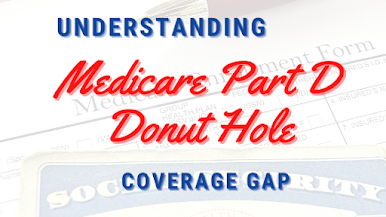Understanding the 2022 Medicare Part D Donut Hole Coverage Gap
If you have a Medicare Part D plan for your prescription drugs, you may get a surprise at the pharmacist: The drug you were taking that has been covered all year suddenly isn't covered anymore. Your pharmacist will charge you more for the drug.
If this
happens to you, you've probably run into the Medicare Part D coverage gap,
often called the "donut hole."
Here's how it
works:
Once you and
your plan have spent a certain dollar amount within a calendar year, coverage
ceases. You'll have to spend more for drugs out of pocket, or find some other
resources, until you hit a catastrophic coverage threshold. At that point,
Medicare Part D will cover your prescription drugs again, as it did before.
As of 2022,
you'll run into the donut hole once you've spent $4,430 in prescription drug
costs. Once you hit that threshold, your coverage decreases, and you will need
to pay 25% of the cost of brand-name drugs and also 25% of the cost of
generics. You'll continue to be charged this amount until you reach the
catastrophic coverage threshold of $7,050 on prescription drugs during the
calendar year. You then exit the donut hole and move to the catastrophic
coverage phase.
You’ll probably Exit the Donut Hole (Coverage Gap) Faster than You
Think
When
you are in the donut hole and paying 25% of covered drugs, your spending counts
toward exiting the gap. But also the drug manufacturer’s discount of 70% also
counts and will help you exit the gap faster. (Notice that 25% + 70% does not
equal 100%) There are two things that do not count towards closing the gap.
1.
The amount that your drug plan pays toward the cost
of the drug, which is 5% in the gap
2.
The amount that the drug plan pays toward the
pharmacy’s dispensing fee, which is 75% of the fee in 2021
Keep
in mind that there are other things that don’t count toward reaching the
catastrophic limit, which are your plan premium and also what you spend on any
drugs that aren’t covered by your Part D plan.
Once you have
emerged from the donut hole and you are in the catastrophic coverage phase, you
will be charged not more than 5% of your prescription drug costs from that
point.
If you have a
Medicare Advantage plan with Part D benefits, you are likely to experience the
same donut hole problem. Just because it is not a stand alone Part D plan makes
little difference, but check your plan specifics or look for another plan
during the Annual Election Period. The best way to avoid the donut hole is to
try to manage your drug expenses. One way to pick a plan that has the drugs that
you use in its formulary. Remember that everything resets January 1.
If you have
low income, you may qualify for “Extra Help”. Check with the Social Security
Administration. Folks receiving Extra Help can avoid the donut hole entirely.
How to Reduce Drug Costs
- Switch
to generics. Speak with your doctor or pharmacist and
ask about any generics that may be available. Many brand-name drugs have
generic equivalents available at a fraction of the cost.
- Switch
to mail order pharmacies. Mail order companies can often provide
drugs at steep discounts compared to bricks-and-mortar stores.
- Shop
around. Some plans provide better coverage
during the coverage gap period. You may need to pay a higher premium, but
it may be worth it if you spend more than $4,130 on prescription drugs.
Before switching, check to ensure the drugs you are taking are in the plan
formulary, and therefore covered.
- Enroll
in a State Pharmaceutical Assistance Program. Most
states maintain and fund their own program to help lower-income or
disabled Medicare beneficiaries with drug costs. Each state's program
varies, but you may qualify for assistance with premiums, deductibles or
copays.
- Apply
for the Extra Help program. The Extra Help program is a Medicare and
Medicaid-run program that helps those with limited financial resources
cover the cost of prescription drugs. Most people who qualify will receive
the following benefits:
- No premiums
- No deductibles (except when
receiving a partial subsidy)
- Cost of not more than $8.35
for each drug covered under their plan.
Note: Never
stop paying Medicare Part D premiums. If you cease doing so, you could get
disenrolled from the program, and be subject to a permanent late-enrollment
penalty when you try to sign up again. The penalty is permanent and 1% for
every month you were not enrolled and did not have “credible” coverage (equal
or better coverage such as through an employer).
Finding
Assistance
It
is best to check for your state’s resources. An independent insurance agent can
also help or point you in the right direction.




Comments
Post a Comment